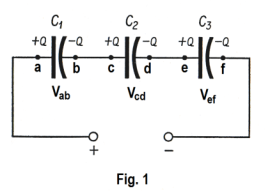
Website owner: James Miller
Prove. The equivalent capacitance CE of n capacitors C1, C2, ... , Cn connected in series is given by

![]()
where C1, C2, ... , Cn are the capacitances of the capacitors.
Proof. We will prove it for three capacitors C1, C2, and C3.
Referring to Fig. 1, if the left plate of capacitor C1 receives a charge +Q, then an equal negative charge -Q will be induced on the right plate. Now if a negative charge -Q appears on the right plate of C1, then a positive charge +Q must appear on the left plate of C2 since the right plate of C1, the left plate of C2, and the wire connecting them can be viewed as a single electrical conductor that was originally uncharged and is isolated from the rest of the circuit. Thus each capacitor receives a charge of magnitude Q on each of its plates as shown in the figure. Now
2) Vaf = Vab + Vcd + Vef
and, by definition of capacitance,
3) C1 = Q / Vab C2 = Q / Vcd C3 = Q / Vef
Substituting 3) into 2) gives
4) Vaf = Q / C1 + Q / C2 + Q / C3
Now an equivalent capacitance CE for this arrangement is the capacitance of a single capacitor that would become charged with the same charge Q when the potential difference across its terminals is Vaf . Consequently,
5) CE = Q / Vaf
From 4) and 5) we get
6) Q / CE = Q / C1 + Q / C2 + Q / C3
which becomes
6) 1 / CE = 1 / C1 + 1 / C2 + 1 / C3
We note that the energy of the single equivalent capacitor is equal to the sum of the energies of capacitors C1, C2, and C3. The energy of the equivalent is ½ QVaf and the sum of the energies of
capacitors C1, C2, and C3 is ½ QVab + ½ QVcd + ½ QVef = ½ QVaf .